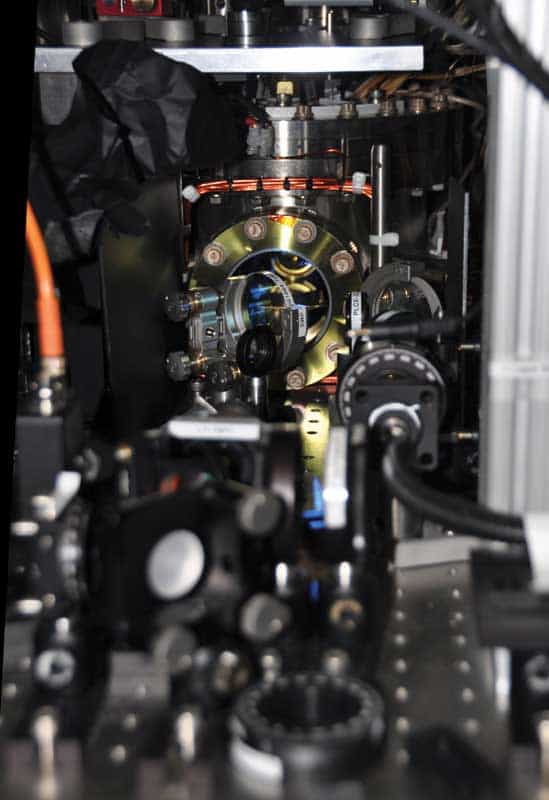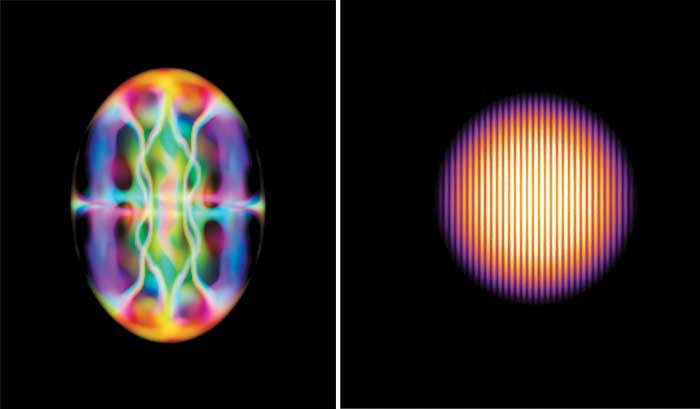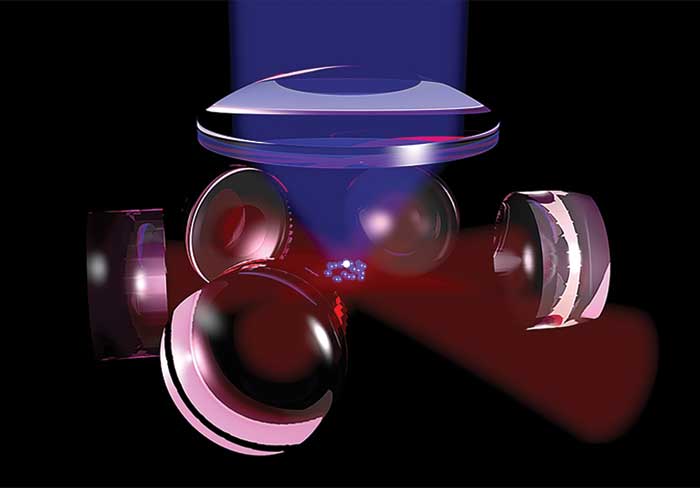Following a false alarm in 2004, two groups report what could be the first observation of supersolids, a theoretically predicted state of matter that is both a superfluid and a solid at the same time. Stephen Ornes reports

We learn it from a young age: solids hold their shapes; liquids flow. Physical states of matter are mutually exclusive. A solid occupies a particular position in space, its molecules fixed. A fluid assumes the shape of its container, its molecules in constant motion. But a so-called supersolid, a predicted phase of matter that forms only under extreme circumstances, doesn’t follow this idea of order. To describe supersolids is an exercise in contradictions. On the one hand, they form rigid crystalline structures. On the other, theory predicts that part of their mass also acts like a superfluid – a quantum phase of matter that flows like a liquid, but without viscosity. That combination lets supersolids do things that seem unfathomable to the humdrum, room-temperature, Newtonian world, like flow through themselves – without friction.
Although the Russian physicists Alexander Andreev and Ilya Liftshitz first predicted in 1969 that supersolids could form in helium close to absolute zero, definite proof has been hard to come by, and this elusive phase of matter has largely remained entrenched in the world of theory. That may have changed, though: two independent groups of researchers – one at the Massachusetts Institute of Technology (MIT) in the US, and the other at ETH Zurich in Switzerland – recently reported forming supersolids.
Both of the new papers were posted on the arXiv preprint server in October (arXiv:1610.08194; arXiv:1609.09053), though they have not yet been published in peer-reviewed journals. Experts in the field say that so far, the evidence for supersolids looks convincing, with the usual caveats: namely, that more work and replication are needed. Both teams report coaxing supersolids into existence by manipulating a Bose–Einstein condensate (BEC), a bizarre state of matter that forms when bosons are chilled to within a fraction of a degree above absolute zero.
The near-simultaneous reporting of two cases of supersolids, found using different experimental approaches, is exciting not only because supersolids may now join the ranks of exotic, fundamental phases, like superconductivity and superfluidity, but also because the material has travelled a long and at times rocky path from prediction to experimental evidence.
“There are no scoops in science, only a slow construction of truth,” says physicist Sébastien Balibar at the École Normale Supérieure in Paris, who has conducted research on quantum solids and was not involved in the new studies. “Discoveries are very rarely made in one shot.”
A false start
The latest reports weren’t the first from physicists who suspected they’d formed supersolids. In a study published in 2004, Pennsylvania State University physicist Moses Chan, together with his graduate student Eun-Seong Kim, reported extraordinary results from experiments using helium-4, the most abundant isotope of helium on Earth (Nature 427 225). At cold temperatures, helium-4 can be encouraged to form either a solid (at high pressure) or a superfluid (at standard pressure). Experiments in the 1930s showed that helium undergoes a phase transition to become a superfluid at 2.2 K, below which it exhibits spectacularly bizarre behaviour, like flowing up the walls of its container and out down the sides.

Chan and Kim started with solid helium-4. They put the material in a torsional oscillator – a device that rotates in alternating directions – and lowered the temperature. At a sliver of a degree above absolute zero, the rotation of the device increased in frequency, which suggested that the amount of mass that was rotating had decreased. That change was consistent with the 1969 predictions by Andreev and Liftshitz, who hypothesized that some of the helium’s mass would form a superfluid that could flow through the rest of the solid without friction.
Other groups reproduced the experiment and found the same results, exciting the condensed-matter physics community. Still, doubt lingered, and for years, the results from Chan and Kim remained controversial.
One team that set out to reproduce the experiment comprised John Reppy, a physicist at Cornell University in the US, and graduate student Sophie Rittner. In a paper published in 2006, they reported that the frequency uptick was tied to defects in the solid helium. When they warmed the helium and let it cool slowly – a process called annealing that smooths out defects – the signature of supersolidity vanished. Then, in a paper published in Nature in 2007, physicist John Beamish at the University of Alberta, Canada, and his collaborators challenged Chan and Kim’s findings by suggesting that solid helium wasn’t perfectly stiff but instead had some give, a “giant plasticity”. This effect could allow some atoms to slide past each other, mimicking the properties of supersolidity. In later experiments, Beamish’s group worked with Balibar and his colleagues in Paris to better understand this effect, and bolstered the case for the new explanation.
Chan, ultimately, brought this chapter to its close. Reppy had been Chan’s adviser in graduate school, and Chan set out to redesign his own experiment to test alternative ideas about the supersolid state. In a paper published in 2012 and based on a new set-up, he reported finding no increase in rotational frequency – and thus no evidence for supersolids (Phys. Rev. Lett. 109 155301).
“This is a remarkable piece of science history,” says physicist Tilman Pfau, who studies particle interactions in BECs at the University of Stuttgart, in Germany. “The same author that claims something, gets criticized, goes back to the lab, sees he was wrong and writes a paper about it.”
New experiments
While some researchers continue to pursue the formation of supersolids in helium, many other labs have turned to BECs. Albert Einstein first predicted the existence of this state of matter in 1924, based on theoretical work by Indian physicist Satyendra Bose, but it took decades to develop the machinery needed to test the prediction. The first BEC was created in a lab in Colorado, US, in 1995, when physicists used lasers and magnetic fields to trap a clutch of rubidium atoms as the temperature was reduced as much as possible. Just above absolute zero, the individual atoms all began behaving like one giant superatom – a single quantum entity at its lowest energy state.

Research into the discovery and properties of BECs netted Nobel prizes for physicists Eric Cornell, at the US National Institute of Standards and Technology, and Carl Wieman, then at the University of Colorado Boulder and now at Stanford University, as well as Wolfgang Ketterle at MIT, whose lab is one of the two that has produced new findings on supersolids.
In the two decades since a BEC was first observed, physicists have become adept at finding ways to control every term in the Hamiltonian – the mathematical description of the energy state of the material. It is through tweaking the values of these terms that they’ve been able to probe new fundamental phases of matter, like supersolids.
Physicists often characterize transitions between phases of matter by what kind of symmetry is broken. Liquid water, for example, at the molecular level, looks the same under any transformation. The arrangement of molecules at one place in the liquid looks like the arrangement of molecules at another. But ice is a crystal, which means its structure looks the same only when observed at periodic intervals. So the translational symmetry of the liquid is broken as it becomes a crystal.
Both forming a crystal and forming a superfluid are associated with breaking symmetry; thus, to form a supersolid requires two kinds of symmetry to break simultaneously. First, a superfluid must be formed. An advantage of working with BECs is that it is well known how to make BECs behave like superfluids, making them a natural place to start; another is that physicists know how to vary atom interactions in the material. Second, while this superfluidity is maintained, the superfluid must become regularly ordered into regions of high and low density, like atoms in a crystal. Physicists have posited a variety of ways to stimulate atom interactions that lead to a solid state while maintaining superfluidity, i.e. the long-sought supersolid state.
“Supersolidity is a paradoxical competition between two different and contradictory types of order,” says Balibar. One of those is the order demanded by solidity, where individual atoms line up on a lattice; the other is superfluidity, where the atoms effectively combine, accumulating to the same quantum state. “Atoms in a supersolid should be localized and delocalized at the same time, distinguishable and indistinguishable.”
There may be more than one way to coax a solid from a BEC superfluid. One group that reported its findings in October, led by Tilman Esslinger at ETH Zurich, trapped the BEC at the intersection of crossing lasers, with each laser forming an optical cavity. The interaction of the photons and atoms in the BEC gave rise to self-organization – the hallmark of solidity – even though the material continued to look like a superfluid.
Pfau says the new work “goes clearly beyond” what groups have done before; Balibar, in Paris, says that the results look “convincing” and “the fundamental effect is clearly there”. At the same time, Balibar cautions that although Esslinger’s group claims evidence for spontaneous symmetry breaking, he’d like to see better confirmation. “That’s not totally obvious to me since the period of the supersolid is fixed by the laser wavelength.”
The other group, from Ketterle’s lab at MIT, also used lasers, but with a kind of BEC that takes advantage of the connections between the spin of an atom – an intrinsic quantum property that’s analogous to rotation – and its motion. (Spin–orbit coupling is a physical interaction that underlies many unusual physical phenomena, including topological insulators and some behaviours in superconductors.) The physicists used a laser to transfer some momentum to the atoms in the BEC, which led to the formation of interference patterns. From those patterns emerged tiger-like stripes of alternating density – standing waves – in the material. In its paper, Ketterle’s group reports that this density modulation breaks translational symmetry, the requirement for a solid.
Physicist Thomas Busch, who studies quantum processes in ultracold atomic gases at the Okinawa Institute of Science and Technology, in Japan, says theorists predicted a few years ago that the supersolid stripes should emerge. At the same time, he notes that experimental verification is exciting news to the community.
Neither group explicitly showed that the material could flow through itself, though the papers do offer arguments in favour of superfluidity. Despite past controversies over what is or isn’t a supersolid, Busch says that the vast majority of people will not have a problem calling the entities in the two new studies supersolids. “Figuring out the exact ‘super’ properties of the states created is now an exciting task for the future,” he says.
Beyond supersolids
Finding new states of matter has been a driving force in cold-atom research for decades, and supersolids are the latest bizarre material to join a growing list that already includes things like superfluids and superconductors. For the last two years, Pfau’s group, in Stuttgart, has been exploring quantum ferrofluids – magnetic droplets that can self-organize out of BECs at low temperature. “Nobody would have thought before [we observed the material in the lab] that this was a stable state of matter,” he says. Last year, in a paper published in Nature, the group reported that quantum ferrofluids can also break translational symmetry, which means they might be a good place to search for other supersolids.
Because scientists have been working with BECs for decades, they’ve figured out a lot about how to tame them and tune them to probe fundamental phases of matter. But they’re just getting started, says Busch. Now they’re looking for ways not only to identify other exotic phases, but also to explore what happens when these strange materials are combined, or how they act under other experimental conditions.
“How do these systems actually behave by themselves? How do they react to external stimulation? What happens if we squeeze them?” Busch likens this era of discovery to what happened in the years after BECs were first discovered, when physicists couldn’t wait to get to know the new condensates better. “The first thing people did [to BECs] was to squeeze them – the stuff you do when you get a new toy.”
In addition, he says, physicists want to study the effects of different long-range interactions and better understand how impurities affect the properties of the materials. Impurities could be critical in finding applications for supersolids. Busch notes that in semiconductor research, impurities added through doping can change the conductivity of a material and make it fit a certain use.
Higher dimensions may also be in store. In the preprint from Ketterle’s group, the researchers note a couple of possible future directions: more characterization of the system, for example, or extending their method to a 2D spin–orbit coupling system. Achieving supersolidity in three dimensions would be another major milestone, but breaking symmetries in three dimensions would be difficult to realize in experiments.
Exotic states of matter, like supersolids, show that under extreme conditions our physical reality behaves in bizarre ways that aren’t easy to explain. “The physics of cold atoms is some kind of simulation of fundamental problems that are well defined, but hard to calculate,” says Balibar. Theory may predict a spectrum of undiscovered properties that emerge in idealized matter, but controlling such strange stuff under extreme conditions is difficult. “Real matter has defects and surface states,” he says, “so our understanding of real matter is far from being complete.”
- Enjoy the rest of the February 2017 issue of Physics World in our digital magazine or via the Physics World app for any iOS or Android smartphone or tablet. Membership of the Institute of Physics required



